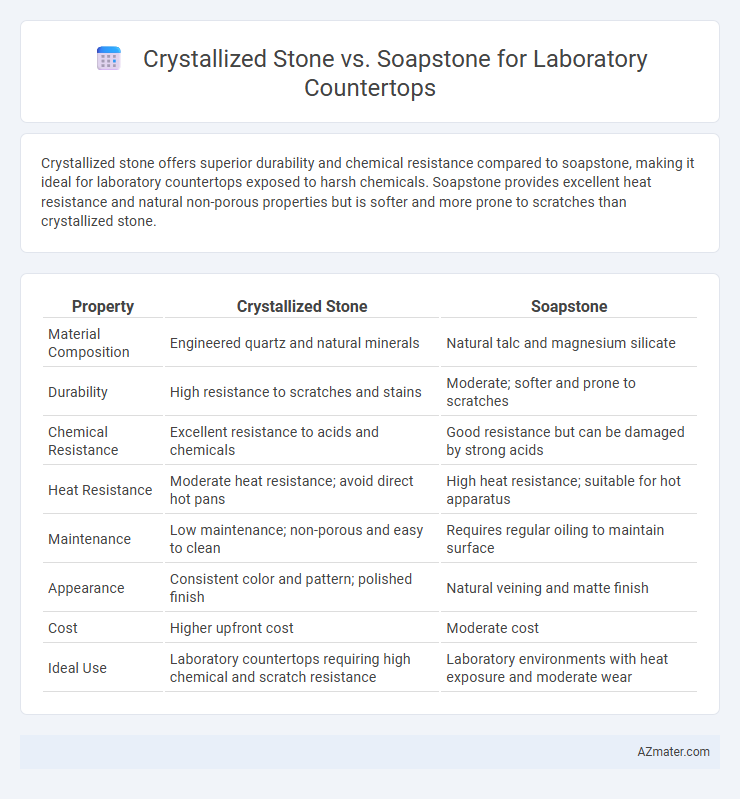Crystallized stone offers superior durability and chemical resistance compared to soapstone, making it ideal for laboratory countertops exposed to harsh chemicals. Soapstone provides excellent heat resistance and natural non-porous properties but is softer and more prone to scratches than crystallized stone.
Table of Comparison
| Property | Crystallized Stone | Soapstone |
|---|---|---|
| Material Composition | Engineered quartz and natural minerals | Natural talc and magnesium silicate |
| Durability | High resistance to scratches and stains | Moderate; softer and prone to scratches |
| Chemical Resistance | Excellent resistance to acids and chemicals | Good resistance but can be damaged by strong acids |
| Heat Resistance | Moderate heat resistance; avoid direct hot pans | High heat resistance; suitable for hot apparatus |
| Maintenance | Low maintenance; non-porous and easy to clean | Requires regular oiling to maintain surface |
| Appearance | Consistent color and pattern; polished finish | Natural veining and matte finish |
| Cost | Higher upfront cost | Moderate cost |
| Ideal Use | Laboratory countertops requiring high chemical and scratch resistance | Laboratory environments with heat exposure and moderate wear |
Introduction to Laboratory Countertop Materials
Laboratory countertops require materials that offer durability, chemical resistance, and ease of maintenance, making crystallized stone and soapstone popular choices. Crystallized stone provides superior hardness and resistance to scratches and chemicals due to its engineered composition primarily of quartz and resin. Soapstone, a natural metamorphic rock composed mainly of talc, offers excellent resistance to acids and heat but is softer and requires more maintenance compared to crystallized stone.
What is Crystallized Stone?
Crystallized stone is a durable, engineered surface made through a high-temperature sintering process combining natural minerals and resins, ideal for laboratory countertops due to its resistance to chemicals, abrasion, and heat. Unlike soapstone, which is a softer, natural metamorphic rock primarily composed of talc, crystallized stone offers enhanced strength and non-porous properties, minimizing staining and bacterial growth in lab environments. Its engineered composition allows for customizable aesthetics and superior performance under rigorous laboratory conditions.
What is Soapstone?
Soapstone is a dense, non-porous metamorphic rock composed primarily of talc, making it resistant to heat, chemicals, and stains, ideal for laboratory countertops. Unlike crystallized stone, which is engineered and often contains quartz or resins, soapstone naturally withstands corrosive substances and thermal shock, providing durability and low maintenance in laboratory environments. Its smooth, matte surface also offers excellent chemical resistance, making it a preferred choice for handling acids and other reactive chemicals safely.
Durability Comparison: Crystallized Stone vs Soapstone
Crystallized stone offers superior durability for laboratory countertops due to its high resistance to scratches, stains, and chemical corrosion, outperforming soapstone's naturally softer and more porous surface. Soapstone, while moderately durable and chemically resistant, is prone to scratching and requires regular maintenance to preserve its integrity. The dense, non-porous structure of crystallized stone minimizes absorption and wear, making it a more robust choice for demanding laboratory environments.
Chemical Resistance and Laboratory Safety
Crystallized stone for laboratory countertops offers superior chemical resistance due to its dense, non-porous surface that withstands acids, solvents, and alkalis without degradation, ensuring longevity and reduced contamination risk. Soapstone, while naturally heat resistant and chemically inert against many acids, is softer and more prone to scratches or etching from strong alkalis and strong oxidizing agents, potentially compromising surface integrity over time. For laboratory safety, crystallized stone's robustness minimizes hazardous chemical absorption and microbial growth, making it the preferred choice in high-usage research environments requiring stringent contamination control.
Maintenance and Cleaning Requirements
Crystallized stone laboratory countertops require minimal maintenance due to their non-porous surface, resisting stains and chemical spills effectively, while soapstone demands regular sealing to maintain its protective patina. Cleaning crystallized stone involves simple use of mild detergents and water, avoiding abrasive cleaners that can damage the glossy finish, whereas soapstone can be cleaned with gentle soap and water, but may darken or develop a natural patina over time. Both materials resist heat and chemicals, but crystallized stone's durable surface offers superior ease of upkeep in high-use laboratory environments.
Aesthetic Appeal and Design Flexibility
Crystallized stone offers a sleek, polished surface with vibrant color options and natural veining that enhance laboratory aesthetics. Soapstone provides a matte finish with subtle, earthy tones, lending a timeless, rustic charm and high resistance to chemical stains. Design flexibility in crystallized stone allows for precise edges and custom shapes, while soapstone's softer texture supports easy fabrication but limits intricate detailing.
Cost Analysis and Budget Considerations
Crystallized stone countertops for laboratories typically cost between $50 and $100 per square foot, offering high durability and stain resistance that justify the initial investment. Soapstone, priced around $70 to $120 per square foot, provides excellent chemical resistance and longevity but may require more frequent sealing, impacting maintenance budgets. Budget considerations should weigh upfront material costs against long-term durability and maintenance expenses to optimize laboratory countertop investment.
Environmental Impact and Sustainability
Crystallized stone countertops, made from engineered natural minerals and resins, offer high durability with low maintenance but involve energy-intensive manufacturing and synthetic resin use, impacting environmental sustainability. Soapstone is a natural, non-porous material with low chemical processing requirements and exceptional longevity, promoting a smaller carbon footprint and easier recyclability. Choosing soapstone supports a more eco-friendly laboratory environment through its natural origin and minimal production emissions compared to crystallized stone.
Choosing the Best Countertop for Your Laboratory
Crystallized stone offers exceptional durability and chemical resistance, making it ideal for laboratory countertops exposed to harsh chemicals and frequent wear. Soapstone provides excellent heat resistance and a non-porous surface, reducing staining and bacterial growth, but it is softer and more prone to scratches compared to crystallized stone. Selecting the best countertop depends on balancing the need for chemical resilience, thermal stability, and maintenance requirements specific to your laboratory environment.

Infographic: Crystallized stone vs Soapstone for Laboratory Countertop
 azmater.com
azmater.com